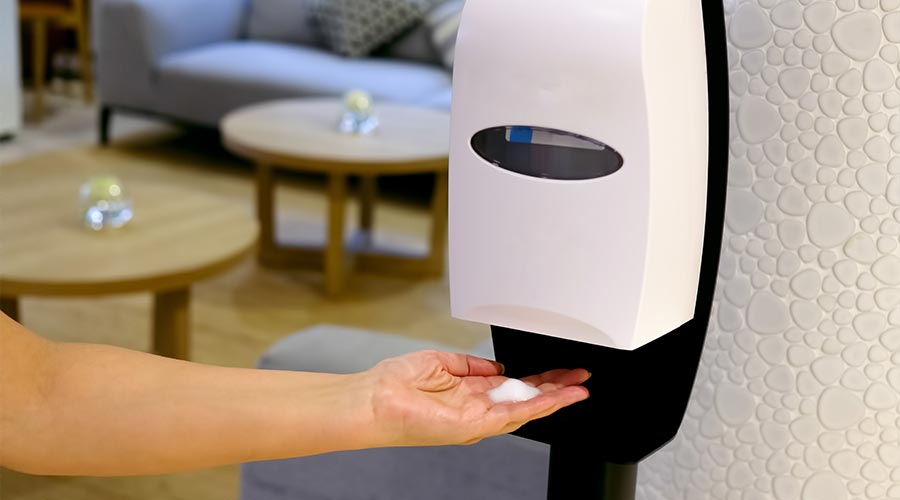
In addition to cueing people with signage, facilities can drive compliance by supporting hand hygiene routines. Consultants agree that one of the best ways to do this is to increase accessibility to soap and hand sanitizer dispensers.
“Make dispensers available, and put them where people will see them, because if they see them, they will use them,” says Gerba, who recommends placing hand sanitizer stations at restroom exits, food prep areas and classroom entrances.
Gerba estimates that half of his students use the hand sanitizer dispenser before entering his classroom, a rate that he found impressive.
“This generation is more sensitized to the importance of hand hygiene because of the pandemic — and that’s a good thing,” he says.
One area that is generally overlooked, however, is the break room.
"You can find more fecal bacteria in a break room than in a restroom because they aren’t deep cleaned and disinfected like restrooms are,” Gerba says. “I think a soap or hand sanitizer dispenser in these locations would be a good idea because people are spreading both germs along with their gossip.”
Convenience and accessibility are equally important when it comes to soap dispensers. Hicks recommends placing them over a sink or counter so that they don’t drip on the floor. And if the restroom is frequented by young children, accessibility is paramount.
“Sinks are made for adults, not children,” Gerba observes. “If you’re dealing with young children, they may not be able to reach the soap or faucet. Making one sink lower than the others may be a good idea so that it’s convenient for a small child to wash their hands.”
Experts also advocate using cartridge systems in place of bulk soap dispensers, which are usually topped off with new soap and seldom cleaned, making them more susceptible to contamination. Gerba has conducted studies on refillable dispensers that confirm the growth of bacteria in soap.
“It turns out some fecal bacteria grow in soap,” he says. “That’s how we isolate them because they’re resistant to being killed by it.”
Handwashing Winners
When it comes to improving hand hygiene, the final stage of habit formation — the reward — is less tangible than the cues and routines that brought about the change. After all, it is difficult to incentivize personal habits that should be second nature. Experts say that for facility cleaning managers, the satisfaction of knowing that they are doing their part in preventing the spread of infection is rewarding enough.
“The reward should be improved health, but in the short term we should feel better about what we are doing, and I think we do,” says Rathey.
Although handwashing habits are by-and-large subpar, consultants hope that ongoing education and reminders about the role of handwashing in preventing the transmission of disease will lead to meaningful change.
“People say that more than half of the illnesses we get are due to your hands, so it's self-inoculation,” notes Gerba. “The average person touches their face every three or four minutes without realizing it.”
In addition to regular handwashing, Rathey encourages facilities not to overlook the importance of cleaning and sanitizing touchpoints to reduce hand-to-surface and surface-to-hand contamination.
“Creating and maintaining the culture of clean would be the key to a long-term, properly executed and sustainable handwashing program,” he says. “If you create the culture of clean, people are going to be more aware of that issue. Our job as facility experts is to try to create those habits; the cues, the routine and then the reward.”
By educating occupants on the dangers of poor hand hygiene, reinforcing messages with signage and other promotional tactics, and ensuring easy and frequent accessibility to dispensers, facility cleaning managers can hold up their end of the bargain when it comes to establishing a strong defense against infections.
Kassandra Kania is a freelance writer based in Charlotte, North Carolina, and is a frequent contributor to Facility Cleaning Decisions.
How to Improve Hand Hygiene Programs

 Celebrating BSCAI's 60th Anniversary eBook
Celebrating BSCAI's 60th Anniversary eBook The Down and Dirty on Cleaning in Virus Season
The Down and Dirty on Cleaning in Virus Season How Surfactant Use is Expanding in Commercial Cleaning
How Surfactant Use is Expanding in Commercial Cleaning